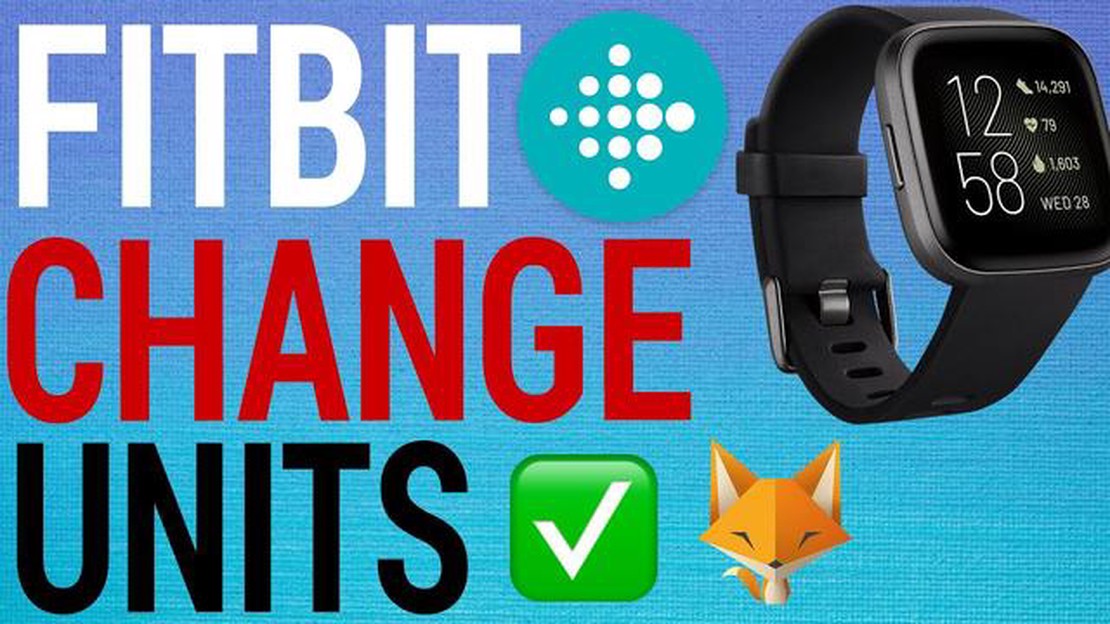Discover the Top 5 Free VPNs for UAE in 2021
5 Best Free VPN For UAE If you live in the United Arab Emirates (UAE), you might already be aware of the limitations placed on internet usage. Many …
Read Article
If you own a Fitbit device, you know how important it is to keep track of your health and fitness goals. Fitbit devices offer a range of features, including the ability to track steps, calories burned, sleep patterns, and more. However, one key aspect of using a Fitbit device is ensuring that the measurements and units of measurement are accurate and aligned with your personal preferences.
Changing the units of measurement on a Fitbit device is a simple process that can be done in just a few steps. Whether you prefer to track your activity in miles or kilometers, or your weight in pounds or kilograms, Fitbit allows you to customize these settings to suit your needs.
To change the units of measurement on your Fitbit device, follow the steps below:
Once you have changed the units of measurement on your Fitbit device, all future data and measurements will be displayed in the new units. This makes it easier for you to track your progress and understand the information provided by your Fitbit device.
Remember, it’s important to regularly check and adjust the units of measurement on your Fitbit device to ensure that you are accurately tracking your health and fitness goals. Being able to customize these settings based on your personal preferences can greatly enhance your overall Fitbit experience.
Changing the units of measurement on a Fitbit device allows you to personalize the data it provides to better align with your preferences and needs. By customizing the units, you can easily understand and interpret the information displayed on your Fitbit device, making it more meaningful and useful in achieving your health and fitness goals.
Here are a few reasons why changing the units of measurement on your Fitbit device can be beneficial:
Overall, changing the units of measurement on your Fitbit device offers greater flexibility and customization, allowing you to track and interpret your health and fitness data in a way that suits your individual needs and preferences. This can enhance your overall experience with your Fitbit device and help you stay motivated on your wellness journey.
Read Also: Why Is Your Samsung Galaxy J7 Not Receiving Software Updates? Find Out Here!
Switching measurement units on your Fitbit device can provide several benefits and improve your overall fitness tracking experience. Here are some advantages of changing the measurement units:
Overall, switching measurement units on your Fitbit device offers personalization, compatibility, accuracy, global use, and convenience. It empowers you to make the most out of your fitness tracking experience and helps you reach your health and wellness goals more effectively.
Read Also: How To Fix Hulu Not Working On Chromecast: Troubleshooting Guide
If you have a Fitbit device and want to change the units of measurement it displays, follow these simple steps:
Now your Fitbit device will display the measurements in the units you have chosen. If you ever want to switch back to the default units, simply follow the same steps and select the default options in the units menu.
No, you cannot change the units of measurement directly from your Fitbit device. You need to use the Fitbit app on your smartphone to make this change.
For weight, you can choose between kilograms (kg) and pounds (lb) as your units of measurement.
No, changing the units of measurement on your Fitbit device does not affect the accuracy of the data it tracks. It only changes the way the data is displayed on the device and in the Fitbit app.
Yes, it is possible to change the units of measurement for weight, height, distance, and temperature separately. The Fitbit app allows you to customize the units for each category according to your preference.
5 Best Free VPN For UAE If you live in the United Arab Emirates (UAE), you might already be aware of the limitations placed on internet usage. Many …
Read ArticleHow To Screen Record On Galaxy S22 If you have recently purchased the new Galaxy S22 and want to record your screen, you’re in luck! The Galaxy S22 …
Read ArticleHow To Pair A PS4 Wireless Controller With Galaxy S10 If you are a proud owner of a Samsung Galaxy S10 smartphone and love gaming, you might want to …
Read ArticleHow To Fix S10 Notification Problems After Android 10 Update If you own a Samsung S10 and recently updated your device to Android 10, you may have …
Read ArticleHow To Fix Lost Ark Cannot Connect To The Server Error If you are a gaming enthusiast, you may have encountered the “Lost Ark Cannot Connect To The …
Read Article9 Best TV With Chromecast Built-In And Ready in 2023 Are you tired of constantly switching between devices to stream your favorite shows and movies? …
Read Article